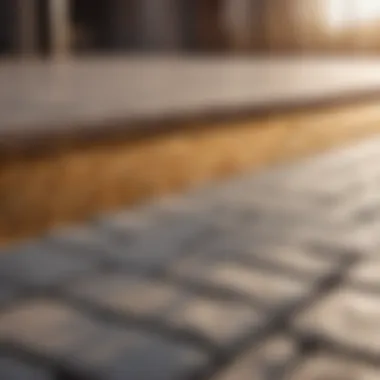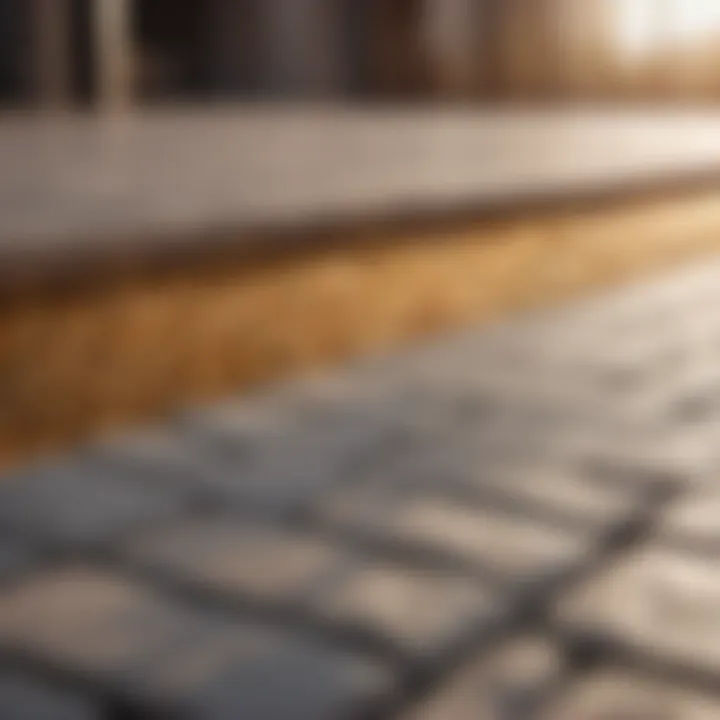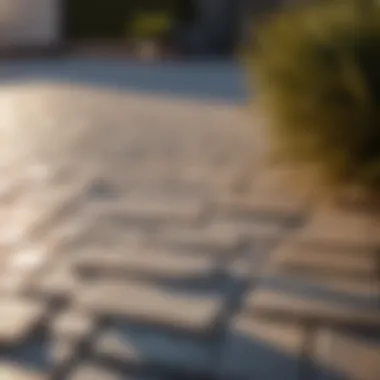Materials:
To embark on your concrete paver installation project, you will need the following materials:
- Concrete pavers: 200 pieces of 12" x 12" square pavers
- Sand: 10 bags of leveling sand
- Gravel: 5 cubic yards of compactable gravel
- Edging: 50 linear feet of heavy-duty plastic or metal edging
- Landscape fabric: 250 square feet of weed-blocking fabric
- Paver joint sand: 5 bags of polymeric sand for joint stabilization
- Paver sealer: 3 gallons of sealant to protect the pavers
DIY Steps:
Now, let's proceed with the step-by-step instructions for installing concrete pavers in your backyard:
- Begin by outlining the area where you want to install the pavers, ensuring it is square and well-measured.
- Excavate the marked area to a depth of 6 inches, removing any grass, roots, or debris.
- Compact the soil and add a 4-inch layer of gravel, leveling it carefully to create a sturdy base.
- Lay landscape fabric over the gravel to prevent weed growth and ensure stability.
- Spread a layer of sand over the fabric, adding an inch at a time and leveling as you go.
- Start laying the concrete pavers in your desired pattern, tapping them gently with a rubber mallet to set them securely.
- Install the edging around the perimeter of the pavers to keep them in place and provide a neat finish.
- Fill the joints between the pavers with polymeric sand, sweeping it across the surface and compacting it to prevent shifting.
- Apply a coat of paver sealer once the sand has settled, following the manufacturer's instructions for optimal protection.
Technical Aspects:
Make sure to have the right tools on hand for a seamless installation process:
- Tape measure and marking paint
- Shovel and wheelbarrow for excavation
- Leveling tool and rubber mallet
- Tamper for compacting soil and gravel
- Broom and blower for cleaning the surface
- Paintbrush or roller for applying sealer
Timing is crucial in each step to ensure proper alignment and stability of the pavers. Use critical techniques such as proper base compaction and joint sanding to enhance the longevity and aesthetics of your DIY project.
DIY Project Process:


Follow these sequential steps for a successful concrete paver installation:
- Start with thorough preparation and precise measurements to avoid errors in the layout.
- Progress through each stage meticulously, taking care to compact the base and level the surface for even paver placement.
- Troubleshoot any unevenness or misalignments promptly to maintain a professional-looking finish.
- Stay attentive to detail and follow the recommended timelines for curing and sealing the pavers to optimize their performance and durability.
For troubleshooting tips, address any settling of pavers by adding more sand or leveling the base as needed. Regularly inspect the paver joints for any gaps and fill them in to prevent shifting over time, ensuring a seamless and lasting installation.
Introduction


In the realm of construction and landscaping projects, understanding the costs associated with installing concrete pavers is paramount. This introductory section of the article sets the stage for a detailed exploration of the financial implications involved in such endeavors. By delving into the intricacies of budgeting for concrete paver installation, readers gain a comprehensive understanding of the monetary considerations that play a significant role in any construction project. From material expenses to labor costs, every aspect is meticulously dissected to equip individuals with the knowledge necessary to make informed decisions regarding their construction ventures.
Overview of Concrete Pavers
Concrete pavers are a versatile and popular choice for various projects due to their durability, aesthetic appeal, and customization options. These precast concrete blocks come in a myriad of shapes, sizes, and colors, allowing for creative designs in different outdoor spaces. Whether used for driveways, patios, walkways, or pool decks, concrete pavers offer a cost-effective solution that can enhance the overall look and functionality of a property. With their ability to withstand heavy loads and endure harsh weather conditions, concrete pavers present a long-lasting paving option that requires minimal maintenance.
Importance of Cost Analysis
Cost analysis is a crucial aspect of any construction project, including the installation of concrete pavers. Understanding the breakdown of costs involved in such endeavors empowers individuals to plan their budget effectively and make strategic decisions. By conducting a detailed cost analysis, homeowners and contractors can identify potential areas for cost savings, negotiate better deals, and ensure that their project stays within budget constraints. Moreover, a comprehensive cost analysis enables stakeholders to allocate resources efficiently, avoid financial surprises, and ultimately achieve the desired outcome without compromising on quality or design.
Cost Components


Cost components play a crucial role in the detailed analysis of installing concrete pavers. Understanding the breakdown of material costs, labor expenses, equipment charges, and overhead and miscellaneous costs is essential for planning and budgeting accurately. By scrutinizing each component meticulously, individuals can make informed decisions about their construction projects, ensuring financial prudence and effective resource allocation.
Material Costs
Types of Concrete Pavers
Concrete pavers come in various types such as interlocking, permeable, and traditional pavers. Each type offers unique characteristics and benefits, ranging from durability and versatility to aesthetic appeal and environmental friendliness. The choice of concrete pavers depends on the project requirements, desired aesthetics, and budget considerations. Understanding the different types helps in selecting the most suitable option for the specific installation, ensuring long-lasting and visually appealing results.
Quantity Required
Determining the quantity of concrete pavers needed involves calculating the surface area to be covered and accounting for wastage and additional marker pieces. Accurately estimating the quantity required ensures seamless installation without delays or the need for additional orders, optimizing costs and project efficiency. Proper planning and calculation play a vital role in avoiding under or overestimation of materials, contributing to cost-effectiveness and project success.
Cost of Base Materials
The cost of base materials consists of the expenses associated with the foundation layers, including gravel, sand, and leveling materials. High-quality base materials are essential for providing a stable and durable base for the concrete pavers, reducing the risk of uneven surfaces or structural issues. While investing in premium base materials may increase initial expenses, it contributes to the longevity and performance of the paved area, minimizing maintenance and repair costs in the long run.
Labor Expenses
Installation Charges
Labor expenses encompass the charges for professional installation services, including preparation, laying, and finishing of the concrete pavers. Installation charges are influenced by factors such as project size, complexity, and contractor rates. Hiring experienced professionals ensures expert installation, precise alignment, and efficient completion of the project. While labor costs constitute a significant portion of the budget, they are crucial for achieving high-quality results and ensuring the structural integrity of the paved area.
Additional Labor Costs
Additional labor costs may arise from unforeseen circumstances, project modifications, or supplemental services required during the installation process. Having a contingency budget for additional labor expenses allows for flexibility in handling unexpected needs or last-minute changes without compromising the project timeline or quality standards. Effective communication with contractors and clear documentation of labor agreements help in managing and controlling additional costs efficiently.
Equipment Charges
Tools and Machinery Rental
Equipment charges involve renting or purchasing tools and machinery essential for concrete paver installation, such as compactors, saws, and leveling devices. Proper equipment selection and maintenance are crucial for ensuring safety, precision, and efficiency during the installation process. Renting specialized tools can be a cost-effective option for one-time projects, while owning equipment may be beneficial for frequent or large-scale installations. Investing in quality equipment enhances productivity and minimizes errors, contributing to successful project outcomes.
Overhead and Miscellaneous Costs
Permit Fees
Permit fees are regulatory costs issued by local authorities for obtaining approval to commence construction work. Understanding and complying with permit requirements are essential for legal compliance and avoiding potential fines or delays. While permit fees add to the overall project expenses, they ensure adherence to building codes, safety regulations, and zoning laws, contributing to the smooth progression of the installation process. Properly budgeting for permit fees and application procedures enhances project planning accuracy and prevents legal complications.
Transportation Expenses
Transportation expenses cover the costs associated with importing materials, delivering equipment, and transporting waste materials during the construction phase. Efficient logistics planning, route optimization, and vendor coordination help in minimizing transportation costs and logistical challenges. Timely delivery of materials and equipment is crucial for project continuity and avoiding construction delays. Considering transportation expenses in the budgeting process ensures smooth project management and cost efficiency, enhancing the overall success of the concrete paver installation.
Cost Comparison
In this section, we delve into the critical aspect of cost comparison in this article, focusing on providing readers with a comprehensive understanding of the financial implications associated with installing concrete pavers. Cost comparison plays a pivotal role in assisting individuals in making informed decisions when embarking on construction projects. By comparing the costs involved in using concrete pavers versus alternative materials, readers can weigh the benefits and drawbacks to determine the most cost-effective approach for their specific needs.
Concrete Pavers vs. Alternative Materials
Differences in Installation Costs
When discussing installation costs, concrete pavers present a unique advantage due to their relatively straightforward installation process compared to alternative materials. The key characteristic of concrete pavers lies in their versatility and ease of installation, making them a popular choice for various construction projects. Additionally, the interlocking nature of concrete pavers ensures a secure and durable surface, minimizing long-term maintenance requirements. This feature provides a significant advantage in terms of both cost and convenience, making concrete pavers a preferred option for those prioritizing efficiency and durability in their construction endeavors.
Long-term Maintenance Charges
Long-term maintenance charges for concrete pavers are notably lower when compared to alternative materials. The key characteristic of concrete pavers in this aspect is their inherent durability and resistance to wear and tear over time. This characteristic not only reduces the need for frequent repairs but also translates into cost savings for homeowners in the long run. Moreover, the easy replaceability of damaged pavers further contributes to cost-effectiveness by enabling targeted repairs without the necessity of extensive renovations. Overall, the lower long-term maintenance charges associated with concrete pavers make them a practical and economical choice for individuals seeking durable and low-maintenance paving solutions.
Budgeting Considerations
For individuals planning construction projects involving concrete pavers, understanding budgeting considerations is crucial for effective financial planning. By delving into financial planning strategies specific to concrete paver installation, individuals can optimize their budget allocations and ensure a seamless construction process.
Financial Planning Strategies
Financial planning strategies tailored to concrete paver installation encompass meticulous budgeting, cost estimations, and contingency planning. The key characteristic of these strategies lies in their ability to create a comprehensive financial roadmap that accounts for material costs, labor expenses, and unexpected expenditures. By adopting these strategies, individuals can proactively manage their project finances, mitigate potential budget overruns, and ensure the successful completion of their construction ventures. The unique feature of financial planning strategies is their capacity to provide a structured approach to budget management, empowering individuals to make informed decisions that align with their financial objectives. This proactive approach not only enhances cost-efficiency but also minimizes financial risks, fostering confidence and control throughout the construction process.
Factors Influencing Costs
Project Size and Complexity
The size and complexity of the project directly correlate with the total cost involved in installing concrete pavers. Larger areas requiring extensive paver installation will naturally incur higher material and labor expenses. Moreover, intricate designs or unique patterns demand more time and effort from laborers, contributing to increased overall costs. Understanding how project size and complexity influence pricing allows individuals to tailor their budget estimations accordingly and plan for any additional resources needed for smooth project execution.
Geographical Location
Geographical location plays a significant role in determining the costs associated with concrete paver installation. Regional pricing disparities can impact material costs, labor rates, and overall project expenses, influencing budget considerations for homeowners. Understanding the local market variations in pricing structures enables individuals to assess the feasibility of a project within their area accurately. By acknowledging the nuances of geographical location on cost dynamics, individuals can proactively plan for potential fluctuations and fluctuations in project expenses.
Regional Pricing Disparities
Regional Pricing Disparities reflect the variations in costs for materials and services across different geographic regions. These disparities stem from factors such as supply chain logistics, market demand, and local economic conditions, shaping the pricing landscape for construction projects. By navigating regional pricing disparities strategically, homeowners can leverage cost-effective options and opportunities unique to their area. Understanding the intricacies of regional price disparities empowers individuals to make cost-efficient decisions and maximize the value derived from their concrete paver installations.
Contractor Selection
The choice of contractors greatly influences the overall costs and quality of concrete paver installations. Selecting reputable and experienced contractors ensures the efficient completion of projects within budget constraints. Additionally, different contractors may offer varying pricing structures, creating opportunities for housewives and homeowners to compare quotes and negotiate favorable terms. By carefully evaluating and selecting contractors based on qualifications, track record, and proposed costs, individuals can streamline the installation process and achieve optimal outcomes for their projects.
Cost-saving Strategies
In the realm of installing concrete pavers, understanding cost-saving strategies is pivotal to optimizing your budget and achieving cost-effective outcomes. These strategies encompass various elements that can significantly impact the overall expenses of your project. By delving into specific techniques and approaches geared towards reducing costs, individuals can navigate the financial aspects of paver installation with greater ease and efficiency.
One of the key benefits of implementing cost-saving strategies pertains to minimizing overall expenses without compromising the quality of the project. By exploring innovative cost-saving techniques, individuals can leverage creative solutions to reduce material costs, labor expenses, and overhead charges. This approach allows for a more economical yet high-quality execution of the paver installation, aligning financial prudence with project excellence.
Moreover, considering cost-saving strategies enables individuals to prioritize budget constraints while maximizing the value of their investment. By strategizing cost-cutting measures, such as efficient material usage, optimized labor allocation, and streamlined project management, homeowners and housewives can achieve a balance between affordability and aesthetics.
When contemplating cost-saving strategies, it is essential to factor in considerations about sustainability and long-term benefits. Opting for eco-friendly materials, energy-efficient practices, and durable construction methods not only reduce immediate costs but also contribute to the longevity and resilience of the installed pavers, ensuring lasting value for homeowners.
By integrating cost-saving strategies into the planning and execution phases of concrete paver installation, individuals can tap into a wealth of opportunities to enhance cost efficiency, project sustainability, and overall satisfaction with the end result. Embracing a strategic approach to cost management empowers individuals to make informed decisions, mitigate financial risks, and embark on construction projects with confidence and financial prudence.
Conclusion
In the intricate realm of cost analysis when installing concrete pavers, the importance of a well-rounded conclusion cannot be overstated. As individuals venture into construction projects involving concrete pavers, reaching a well-informed conclusion serves as the cornerstone for success. This final stage encapsulates a myriad of crucial elements and considerations that are pivotal in ensuring a smooth and financially sound endeavor.
One key aspect that the conclusion addresses is the consolidation of all cost components meticulously analyzed throughout the article. By synthesizing material costs, labor expenses, equipment charges, and overhead costs, the conclusion offers a holistic view of the financial landscape associated with concrete paver installation. This comprehensive overview empowers individuals to make informed decisions, align their budgeting strategies, and anticipate potential financial implications with clarity.
Moreover, the conclusion serves as a catalyst for translating budgeting considerations into actionable insights. Delving into financial planning strategies discussed earlier in the article, the conclusion provides a roadmap for housewives and homeowners to navigate the intricacies of budget allocation effectively. This strategic approach aids in optimizing resources, mitigating unforeseen expenses, and ultimately enhancing the overall financial efficiency of their construction projects.
Beyond financial aspects, the conclusion also highlights the significance of reflecting on factors influencing costs and embracing cost-saving strategies. By encapsulating the nuanced interplay between project size, geographical location, and contractor selection, the conclusion directs attention towards key determinants that shape cost dynamics. Additionally, by imparting DIY installation tips and negotiation techniques, the conclusion equips readers with practical tools to potentially minimize costs and maximize value in their concrete paver installations.
In essence, the conclusion serves as a compass guiding individuals from the inception of planning to the fruition of enjoying the results of their concrete paver projects. It consolidates insights, strategies, and considerations accumulated throughout the article, paving the way for informed decision-making, efficient budget management, and ultimately, a successful and gratifying construction experience.





